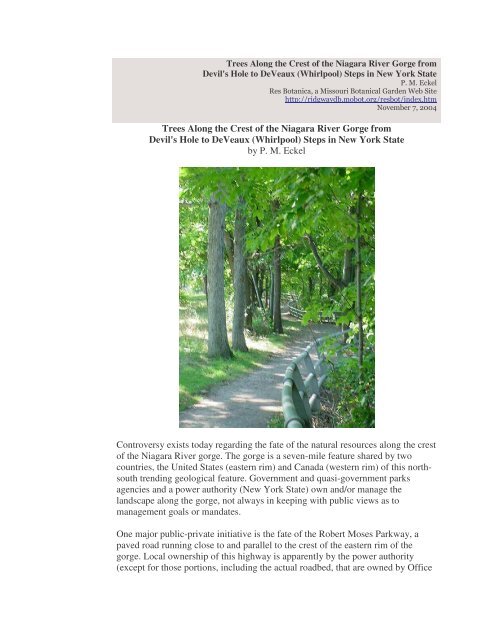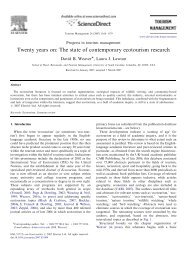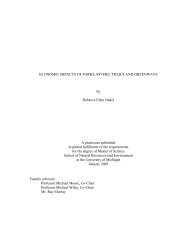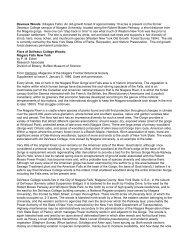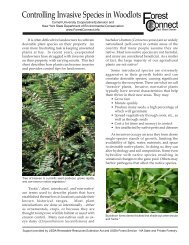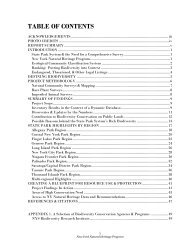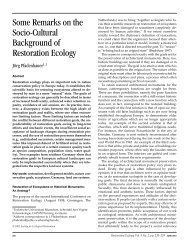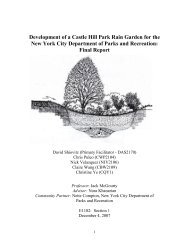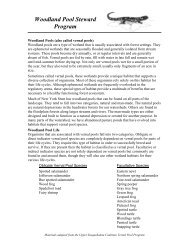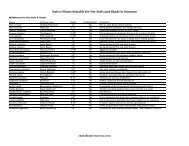Trees Along the Crest of the Niagara River Gorge - Niagara Heritage ...
Trees Along the Crest of the Niagara River Gorge - Niagara Heritage ...
Trees Along the Crest of the Niagara River Gorge - Niagara Heritage ...
Create successful ePaper yourself
Turn your PDF publications into a flip-book with our unique Google optimized e-Paper software.
<strong>Trees</strong> <strong>Along</strong> <strong>the</strong> <strong>Crest</strong> <strong>of</strong> <strong>the</strong> <strong>Niagara</strong> <strong>River</strong> <strong>Gorge</strong> from<br />
Devil's Hole to DeVeaux (Whirlpool) Steps in New York State<br />
<br />
<br />
!"!<br />
#$!%&''(<br />
<strong>Trees</strong> <strong>Along</strong> <strong>the</strong> <strong>Crest</strong> <strong>of</strong> <strong>the</strong> <strong>Niagara</strong> <strong>River</strong> <strong>Gorge</strong> from<br />
Devil's Hole to DeVeaux (Whirlpool) Steps in New York State<br />
by P. M. Eckel<br />
Controversy exists today regarding <strong>the</strong> fate <strong>of</strong> <strong>the</strong> natural resources along <strong>the</strong> crest<br />
<strong>of</strong> <strong>the</strong> <strong>Niagara</strong> <strong>River</strong> gorge. The gorge is a seven-mile feature shared by two<br />
countries, <strong>the</strong> United States (eastern rim) and Canada (western rim) <strong>of</strong> this northsouth<br />
trending geological feature. Government and quasi-government parks<br />
agencies and a power authority (New York State) own and/or manage <strong>the</strong><br />
landscape along <strong>the</strong> gorge, not always in keeping with public views as to<br />
management goals or mandates.<br />
One major public-private initiative is <strong>the</strong> fate <strong>of</strong> <strong>the</strong> Robert Moses Parkway, a<br />
paved road running close to and parallel to <strong>the</strong> crest <strong>of</strong> <strong>the</strong> eastern rim <strong>of</strong> <strong>the</strong><br />
gorge. Local ownership <strong>of</strong> this highway is apparently by <strong>the</strong> power authority<br />
(except for those portions, including <strong>the</strong> actual roadbed, that are owned by Office
<strong>of</strong> State Parks, Recreation and Historic Preservation), but it is maintained by <strong>the</strong><br />
New York State Department <strong>of</strong> Transportation. Currently <strong>the</strong>re is a public<br />
movement to remove this parkway. As it parallels Lewiston Road, it can be<br />
considered to be redundant. This is not <strong>the</strong> case with <strong>the</strong> <strong>Niagara</strong> Parkway on <strong>the</strong><br />
Canadian side that parallels <strong>the</strong> crest, and for which removal is impossible due to<br />
adjacent residential development.<br />
The Parkway begins upstream at <strong>the</strong> North Grand Island Bridge, follows<br />
westward along <strong>the</strong> upper <strong>Niagara</strong> <strong>River</strong> to <strong>the</strong> cataracts in <strong>the</strong> city <strong>of</strong> <strong>Niagara</strong><br />
Falls where <strong>the</strong> <strong>Niagara</strong> Reservation, a State Park, is located. The road turns north<br />
here at <strong>the</strong> sou<strong>the</strong>rn terminus <strong>of</strong> <strong>the</strong> gorge, leaves <strong>the</strong> Reservation, continues along<br />
<strong>the</strong> <strong>River</strong>, following its high bank (<strong>the</strong> gorge rim) along land in part apparently<br />
owned by NYPA with interruptions associated with <strong>the</strong> international bridges,<br />
o<strong>the</strong>r State Parks, and <strong>the</strong> State Parks maintenance garage.<br />
Downstream, <strong>the</strong> roadway bisects two State Parks (DeVeaux State Park and<br />
Whirlpool State Park) in <strong>the</strong> vicinity <strong>of</strong> <strong>the</strong> whirlpool at <strong>the</strong> base <strong>of</strong> <strong>the</strong> gorge,<br />
which is a feature <strong>of</strong> <strong>the</strong> <strong>Niagara</strong> <strong>River</strong>. There is ano<strong>the</strong>r State Park, Devil's Hole<br />
State Park to <strong>the</strong> north, <strong>the</strong> power generating facility <strong>of</strong> <strong>the</strong> New York Power<br />
Authority (NYPA) at <strong>the</strong> nor<strong>the</strong>rn boundary <strong>of</strong> this, <strong>the</strong> gorge terminating to <strong>the</strong><br />
north at Lewiston, New York, at a State Park: Artpark, owned by NYPA but with<br />
a layer <strong>of</strong> management by New York State Parks.<br />
The single consistent public mandate for all <strong>the</strong> agencies is <strong>the</strong> preservation,<br />
protection and restoration <strong>of</strong> <strong>the</strong> native ecosystems along <strong>the</strong> gorge, along its top
and down at <strong>the</strong> river's edge. The present initiative to remove <strong>the</strong> Robert Moses<br />
Parkway, primarily along <strong>the</strong> crest <strong>of</strong> <strong>the</strong> gorge, is within <strong>the</strong> public interest in<br />
correcting what is considered to be an error, and to restore that landscape to its<br />
natural condition.<br />
To help give more precision to <strong>the</strong> exact condition that is desired in this respect,<br />
this author thought it expedient to investigate <strong>the</strong> natural botanical character <strong>of</strong> <strong>the</strong><br />
present crest vegetation, primarily its trees, as trees are <strong>the</strong> primary natural control<br />
<strong>of</strong> <strong>the</strong> ecosystem that develops within and beneath <strong>the</strong> canopy.<br />
To begin this assessment, a field excursion on a single day, September 23, 2004, a<br />
bright, sunny day, was taken along <strong>the</strong> gorge crest from Devil's Hole State Park in<br />
<strong>the</strong> north, towards <strong>the</strong> south, or upstream, to <strong>the</strong> stone stairs just north <strong>of</strong><br />
Whirlpool State Park, a distance <strong>of</strong> about one mile. In future papers, o<strong>the</strong>r sectors<br />
<strong>of</strong> <strong>the</strong> gorge rim will be discussed.<br />
Description <strong>of</strong> <strong>the</strong> <strong>Niagara</strong> <strong>River</strong> <strong>Gorge</strong> <strong>Crest</strong><br />
The gorge <strong>of</strong> <strong>the</strong> <strong>Niagara</strong> <strong>River</strong>, part <strong>of</strong> <strong>the</strong> border between New York State and<br />
<strong>the</strong> Province <strong>of</strong> Ontario, trends in a north-south direction in <strong>the</strong> section between<br />
<strong>the</strong> Whirlpool (DeVeaux) stone stairs from gorge crest to shoreline on <strong>the</strong><br />
upstream end (south) to <strong>the</strong> stone steps at Devil's Hole at <strong>the</strong> downstream end<br />
(north). The eastern, or New York State, shore <strong>of</strong> <strong>the</strong> river faces west and receives<br />
<strong>the</strong> brunt <strong>of</strong> <strong>the</strong> prevailing westerly winds as well as <strong>the</strong> afternoon sun. This<br />
condition tends to make <strong>the</strong> crest (historically known as <strong>the</strong> "High Bank" or gorge<br />
rim or crest, as opposed to <strong>the</strong> "Low Bank" or shoreline at <strong>the</strong> base <strong>of</strong> <strong>the</strong> gorge),<br />
generally arid. The low bank is in shade generally until noontime during <strong>the</strong><br />
autumn. The sunlight exposure on <strong>the</strong> high bank intensifies during daylight hours<br />
in all seasons, and receives pressure toward aridity due to evaporation pressure<br />
from winds coming out <strong>of</strong> <strong>the</strong> west. This aridity is intensified because <strong>of</strong> soil<br />
depths varying from none (in alvar situations where <strong>the</strong> dolomitic bedrock is<br />
exposed at <strong>the</strong> extreme rim) to thin soil to soil <strong>of</strong> some depth in ancient river<br />
deposits. This soil absence or deposition is, in undisturbed areas, a function <strong>of</strong> <strong>the</strong><br />
history <strong>of</strong> <strong>the</strong> river.<br />
When <strong>the</strong> cataracts were situated at <strong>the</strong> extreme north end <strong>of</strong> <strong>the</strong> present sevenmile<br />
gorge, at <strong>the</strong> axis between <strong>the</strong> towns <strong>of</strong> Queenston, Ontario, and Lewiston,<br />
New York, on opposite sides <strong>of</strong> <strong>the</strong> <strong>Niagara</strong> <strong>River</strong>, <strong>the</strong> actual shoreline <strong>of</strong> <strong>the</strong> river<br />
was approximately 250 feet in elevation above <strong>the</strong> level <strong>of</strong> <strong>the</strong> plain <strong>of</strong> <strong>the</strong><br />
ancestral Lake Ontario, when its waters lapped against <strong>the</strong> foot <strong>of</strong> <strong>the</strong> northfacing,<br />
east-west trending <strong>Niagara</strong> Escarpment. The gorge is an invagination <strong>of</strong><br />
this continuous escarpment. As a shoreline, <strong>the</strong> soils <strong>of</strong> what is now <strong>the</strong> crest were<br />
composed <strong>of</strong> river sediments with a mixture <strong>of</strong> erosion byproducts as terrestrial<br />
soils and bedrock interacted with <strong>the</strong> forces <strong>of</strong> <strong>the</strong> river water. Ancient shells and<br />
o<strong>the</strong>r biological debris characteristic <strong>of</strong> this habitat in <strong>the</strong> "upper bank" may still<br />
be exhumed from <strong>the</strong> soils along <strong>the</strong> crest. Soil depth varies as <strong>the</strong> curves in <strong>the</strong><br />
river sometimes drew <strong>the</strong> force <strong>of</strong> <strong>the</strong> water against <strong>the</strong> bank, when erosion and
scouring would occur, and times when <strong>the</strong> force <strong>of</strong> <strong>the</strong> water was directed away<br />
from <strong>the</strong> bank, when deposition occurred. Variation would also derive from <strong>the</strong><br />
breadth and depth <strong>of</strong> <strong>the</strong> river channel, water flowing faster when <strong>the</strong> channel<br />
narrowed and slower as it broadened out.<br />
Each time <strong>the</strong> brink <strong>of</strong> <strong>the</strong> southward-eroding cataracts collapsed through various<br />
erosive pressures, as for example, <strong>the</strong> acidic waters dissolved ever widening<br />
chinks in <strong>the</strong> angular lines <strong>of</strong> breakage in <strong>the</strong> dolomite caprock, coupled with <strong>the</strong><br />
forces <strong>of</strong> hydrostatic pressure (all still active at <strong>the</strong> brinks <strong>of</strong> <strong>the</strong> cataracts as <strong>the</strong>y<br />
occur today seven miles south <strong>of</strong> Lewiston-Queenston), <strong>the</strong> banks <strong>of</strong> <strong>the</strong> river<br />
downstream <strong>of</strong> <strong>the</strong> brink became abandoned, leaving <strong>the</strong>m "high and dry."<br />
The Ancestral <strong>Crest</strong> Forest<br />
The general impression is that <strong>the</strong> forest in this section <strong>of</strong> <strong>the</strong> gorge crest is a dry<br />
mixed Oak-Hickory woodland. The dominant trees are Red Oak (Quercus rubra),<br />
White Oak (Quercus alba) and Pignut Hickory (Carya glabra-ovalis).<br />
Subdominants include primarily Hop-hornbeam (Ostrya virginiana), White Ash<br />
(Fraxinus americana), and Basswood (Tilia americana), with a little Sugar Maple<br />
(Acer saccharum), Black Cherry (Prunus serotina), Tulip Tree (Liriodendron<br />
tulipifera), rarely Black Oak (Quercus velutina) and Shagbark Hickory (Carya<br />
ovata), although I am guessing that at an earlier time <strong>the</strong>re was more <strong>of</strong> this last<br />
tree species. I would suggest, after consultation with Ecological Communities <strong>of</strong><br />
New York State (Reschke 1990) that overall this forest type conforms to <strong>the</strong><br />
Appalachian Oak-Hickory Forest community in <strong>the</strong> Forested Uplands section <strong>of</strong><br />
that booklet. It is a general woodland community that seems to occur "throughout<br />
upstate New York north <strong>of</strong> <strong>the</strong> Coastal Lowlands ecozone; most common south <strong>of</strong><br />
<strong>the</strong> Adirondacks ecozone" (p. 55).<br />
Although this seems to be <strong>the</strong> general community type in this section <strong>of</strong> <strong>the</strong> crest,<br />
<strong>the</strong>re are exceptions, such as <strong>the</strong> presence <strong>of</strong> a Chestnut Oak (Quercus<br />
muhlenbergii) community in <strong>the</strong> sou<strong>the</strong>rn section <strong>of</strong> Whirlpool State Park,with a<br />
match across <strong>the</strong> river in Ontario on Wintergreen Flats. Ano<strong>the</strong>r variation occurs<br />
where soils are deeper and Sugar Maple (Acer saccharum) becomes more<br />
numerous.<br />
Note also that an entirely different forest type exists perched within fissures and<br />
cracks in <strong>the</strong> dolomitic caprock <strong>of</strong> <strong>the</strong> gorge out <strong>of</strong> sight and out <strong>of</strong> mind, and that<br />
is <strong>the</strong> forest <strong>of</strong> Arbor Vitae or Eastern White Cedar (Thuja occidentalis L.)<br />
Although occasionally this evergreen tree is seen along <strong>the</strong> crest, in this section<br />
none were noted. Their presence is screened by <strong>the</strong> shrubs and trees just outside<br />
<strong>of</strong> <strong>the</strong> path-fence.
Looking north, <strong>the</strong>re are three habitats, <strong>the</strong> crest vegetation on <strong>the</strong> left beyond <strong>the</strong> fence where<br />
most <strong>of</strong> <strong>the</strong> native species diversity occurs, <strong>the</strong> central wooded area with canopy with <strong>the</strong> shrub<br />
and herbaceous layers absent due to maintenance by <strong>the</strong> State as a lawn. On <strong>the</strong> right is <strong>the</strong><br />
Parkway and blue sky (canopy absent) with no shaded buffer. The tall grasses and forbs on <strong>the</strong><br />
right hand slope are <strong>the</strong>re because <strong>of</strong> a recent decision by <strong>the</strong> parks administration to not mow. For<br />
what purpose this policy is in effect remains to be seen. Most species growing up are weeds. In <strong>the</strong><br />
foreground is a stump indicating eventual forest morbidity as present trees age and are not<br />
permitted to regenerate nor are <strong>the</strong>y to be replaced by genetically identical <strong>of</strong>fspring.<br />
Present Conditions: The <strong>Crest</strong> Tour from North to South<br />
The area studied is a narrow woodland strip (variably perhaps 30 to 100 or more<br />
feet wide) about one mile in length contained between <strong>the</strong> western boundary <strong>of</strong><br />
<strong>the</strong> asphalted Robert Moses Parkway and <strong>the</strong> crest <strong>of</strong> <strong>the</strong> <strong>Niagara</strong> <strong>River</strong> gorge. On<br />
<strong>the</strong> crest-side <strong>of</strong> this strip a pedestrian path and a metal fence occur, <strong>the</strong> fence<br />
creating a barrier between <strong>the</strong> path and a special forest community in <strong>the</strong> narrow<br />
strip <strong>of</strong> land between <strong>the</strong> fence and <strong>the</strong> drop-<strong>of</strong>f on <strong>the</strong> gorge rim.<br />
There is no buffer where <strong>the</strong> wooded tract abuts <strong>the</strong> Parkway, with lower growing<br />
plants, such as shrubs or small trees, to protect <strong>the</strong> woodland soils from <strong>the</strong> open,<br />
exposed Parkway. A forest buffering structure may be seen in <strong>the</strong> species<br />
composition in <strong>the</strong> extremely narrow strip (perhaps on average less than 10 feet<br />
wide) between <strong>the</strong> fence separating <strong>the</strong> path from <strong>the</strong> open crest <strong>of</strong> <strong>the</strong> gorge.<br />
Such a habitat, protected by <strong>the</strong> fence, gives some indication <strong>of</strong> what <strong>the</strong> crest<br />
habitat might have looked like, especially since <strong>the</strong> woodland under study here is<br />
itself an edge, but an edge to <strong>the</strong> original woods in a more regional context that<br />
once occurred east <strong>of</strong> <strong>the</strong> Parkway in <strong>the</strong> urban areas adjacent to <strong>the</strong> gorge in <strong>the</strong><br />
City <strong>of</strong> <strong>Niagara</strong> Falls.
Looking north from <strong>the</strong> south boundary <strong>of</strong> Devil's Hole State Park one can see <strong>the</strong> unnaturally flat<br />
lawn area and how vulnerable to deterioration <strong>of</strong> <strong>the</strong> natural experience paving this path would be.<br />
Such paving would clutter an already over-modified environment and encourage guttering parallel<br />
to <strong>the</strong> pavement edges, encouraging erosion and <strong>the</strong> introduction <strong>of</strong> more weedy species.<br />
As at Whirlpool State Park, <strong>the</strong> habitat is somewhat disturbed. The canopy, as at<br />
Whirlpool State Park across from DeVeaux College woods, is essentially intact,<br />
casting a dappled shade. The habitat also has lost its shrub layer except on <strong>the</strong> far<br />
side <strong>of</strong> <strong>the</strong> crest fence where a variety <strong>of</strong> native and weedy shrubs occur. The<br />
woodland is relatively clean <strong>of</strong> introduced species (except invasive shrubs, as<br />
discussed below). The European Bird Cherry (Prunus avium L.), seen in so many<br />
<strong>Niagara</strong> woodlands, is absent here except for one old tree in more open ground.<br />
At this time <strong>of</strong> year (September), <strong>the</strong> herbaceous layer is composed <strong>of</strong> various<br />
Aster species and predominately <strong>the</strong> Zig-zag Goldenrod (Solidago flexicaulis L.)<br />
with a little Blue-stemmed Goldenrod (Solidago caesia L.) and ra<strong>the</strong>r tired Early<br />
Goldenrod (Solidago juncea Ait.), because, as <strong>the</strong> earliest <strong>of</strong> <strong>the</strong> Goldenrods to<br />
flower (as early as July), it is well into seedset by late September.<br />
Among <strong>the</strong> Asters, <strong>the</strong> most striking and common is Arrow-leaved Aster (Aster<br />
sagittifolius) with white flowers in full sun, turning somewhat blueish in <strong>the</strong> shade<br />
and as <strong>the</strong> flowers mature. There was surprisingly little Tall White Aster (Aster<br />
simplex Willd.), perhaps because this species is more characteristic <strong>of</strong> meadows in<br />
full sun.<br />
Everywhere <strong>the</strong> ground was covered with thin-stemmed grasses <strong>of</strong> <strong>the</strong> genus Poa,<br />
predominantly Kentucky Blue-grass (Poa pratensis L.) with mixture <strong>of</strong> Poa<br />
nemoralis L. Toward <strong>the</strong> crest <strong>the</strong>re occurs <strong>the</strong> Canada Blue-grass (Poa<br />
compressa L.) which, despite its common name (Canada Bluegrass), is a<br />
European, for instance, species that has subsequently invaded <strong>the</strong> <strong>Niagara</strong>
grasslands, probably at a very early date. These grasses are not typical <strong>of</strong> <strong>the</strong><br />
original soil cover, as in what may be <strong>the</strong> only example <strong>of</strong> untouched crest<br />
vegetation I have seen to date (report in progress). The grasses are so dense that<br />
little bryophyte cover exists on <strong>the</strong> soils, ano<strong>the</strong>r change from <strong>the</strong> original<br />
condition where <strong>the</strong> canopy was more closed, perhaps with <strong>the</strong> addition <strong>of</strong> a shrub<br />
layer. Our native Poa species generally have no rhizomes: Poa compressa and<br />
Poa pratensis both do, hence <strong>the</strong>ir extensive mat-forming colonial presence<br />
throughout <strong>the</strong> <strong>Niagara</strong> woodlands.<br />
Upon leaving <strong>the</strong> parking area near Lewiston Road at Devil's Hole and<br />
approaching <strong>the</strong> pedestrian overpass over <strong>the</strong> Robert Moses Parkway, several very<br />
mature trees occur: Red Oak (Quercus rubra L.), two Hickory trees with<br />
essentially smooth (i.e. hairless) leaves (Carya glabra (Mill.) Sweet, <strong>the</strong> Pignut<br />
Hickory), a large and beautiful, but decidedly horticultural Ginkgo tree (Ginkgoa<br />
biloba L.), two o<strong>the</strong>r Hickory trees with shaggy bark (Shagbark Hickory, Carya<br />
ovata (Mill.) K. Koch), two Tulip trees (Liriodendron tulipifera L.), more Red<br />
Oak, and Black Locust trees (Robinia pseudoacacia L.).<br />
White Oak leaves<br />
On <strong>the</strong> urban-side overpass abutment <strong>the</strong>re was a Siberian Elm (Ulmus pumila<br />
L.), an alien species <strong>of</strong> street tree. On <strong>the</strong> gorge side <strong>of</strong> <strong>the</strong> overpass <strong>the</strong>re was a<br />
Norway Maple planted (Acer platanoides L.), <strong>the</strong> standard regional street tree, as<br />
well as two very large, very old Hawthorns that <strong>the</strong> New York parks<br />
administrations have used to plant in such areas, but which is alien to <strong>the</strong> region,<br />
occurring naturally south <strong>of</strong> our area: <strong>the</strong> Washington Thorn (Crataegus<br />
phaenopyrum Medic.). This shrub has been planted also at Devil's Hole in <strong>the</strong><br />
abandoned nor<strong>the</strong>rn crest sectors <strong>of</strong> <strong>the</strong> park, at Whirlpool State Park, Goat Island
and o<strong>the</strong>r areas.<br />
Immediately an American Basswood tree (Tilia Americana L.) presented itself on<br />
<strong>the</strong> gorge-side <strong>of</strong> <strong>the</strong> path fence. This and o<strong>the</strong>r native species occur on both sides<br />
<strong>of</strong> this fence, creating a canopy that extends from <strong>the</strong> Parkway on <strong>the</strong> left (facing<br />
south) to <strong>the</strong> fence and gorge crest on one's right. The Hop-hornbeam (Ostrya<br />
virginiana (Mill.) K. Koch) is a subdominant whose frequency rises and falls in<br />
swarms along <strong>the</strong> path, as with <strong>the</strong> dominant trees.<br />
Here <strong>the</strong>re are <strong>the</strong> amazingly plentiful <strong>of</strong> <strong>the</strong> Hickory species Pignut and Smallfruited<br />
Hickory (Carya glabra (Mill.) Sweet and Carya ovalis (Wang.) Sarg.)<br />
with <strong>the</strong>se medium to huge-sized compound leaves. Remains <strong>of</strong> <strong>the</strong>ir nuts litter<br />
<strong>the</strong> ground. There is more Hop-hornbeam (whose leaves resemble Birch because<br />
it is a member <strong>of</strong> <strong>the</strong> same family: Betulaceae).<br />
As flowering herbs appear, <strong>the</strong> Goldenrods already mentioned, at least three<br />
species, various Asters, White Snakeroot (Eupatorium rugosum Houtt., <strong>the</strong>re is<br />
one Shagbark Hickory on <strong>the</strong> crest, <strong>the</strong> tired remnant <strong>of</strong> a spring wildflower<br />
population <strong>of</strong> False Solomon's Seal (Smilacina racemosa (L.) Desf.).<br />
There is no getting around <strong>the</strong> sad thickets <strong>of</strong> Buckthorn (Rhamnus cathartica L.)<br />
that crowd <strong>the</strong> crest along <strong>the</strong> fence in <strong>the</strong>ir tedious monoculture. This is <strong>the</strong><br />
number one enemy <strong>of</strong> natural or passive regeneration schemes, <strong>the</strong> number one<br />
invasive species in both natural and disturbed areas. Anywhere and everywhere<br />
this shrub should be eradicated. One escaped shrub <strong>of</strong> <strong>the</strong> alien English Hawthorn<br />
(Crataegus monogyna Jacq.) was seen.<br />
In light-wells where <strong>the</strong> canopy has been broken by tree removal or tree-fall,<br />
weeds flourish: <strong>the</strong> weedy Poas, <strong>the</strong> Bluegrasses already mentioned, and <strong>the</strong><br />
Orchard Grass (Dactylis glomerata L.) that flourishes in <strong>the</strong> unmown open areas<br />
in <strong>the</strong> south sector <strong>of</strong> Whirlpool State Park, where individual culms can rise as<br />
high as five feet in dense lawns with o<strong>the</strong>r weedy species. Note <strong>the</strong> proliferation<br />
<strong>of</strong> <strong>the</strong>se plants along <strong>the</strong> Parkway where <strong>the</strong> canopy ends.<br />
A very small number <strong>of</strong> Sugar Maples (Acer saccharum Marsh.), only seven<br />
inches diameter at breast height, are encountered, which is unusual as most <strong>of</strong> <strong>the</strong><br />
native forest in <strong>the</strong> region has been characterized as Beech-Maple dominated.<br />
Here along <strong>the</strong> crest it appears to be Oak-Hickory, as discussed above.<br />
A Black Cherry (Prunus serotina Ehrh.) crops up here and <strong>the</strong>re all <strong>the</strong> way to<br />
Whirlpool State Park upstream, to <strong>the</strong> south. A small amount <strong>of</strong> weedy<br />
Honeysuckle occurs across <strong>the</strong> fence (Lonicera sp. ei<strong>the</strong>r L. tartarica L. or L.<br />
morrowii Gray).<br />
More Pignut and Small-fruited Hickory with festoons <strong>of</strong> <strong>River</strong> Grape (Vitis<br />
riparia Michx.) occur, <strong>the</strong> Red Oak becomes more conspicuous. Fur<strong>the</strong>r on is
ano<strong>the</strong>r vine, one <strong>of</strong> <strong>the</strong> two species <strong>of</strong> Virginia Creeper in our area, and, some<br />
say, <strong>the</strong> only native one, Par<strong>the</strong>nocissus vitacea (Knerr) Hitchc. A large Norway<br />
Maple occurs on <strong>the</strong> crest, which should be removed, <strong>the</strong>n ano<strong>the</strong>r. Six Hophornbeams<br />
line up in a row, <strong>the</strong>n six Black Locusts (Robinia pseudoacacia),<br />
which should be replaced with native trees.<br />
Black Walnut (Juglans nigra L.) is very infrequent, probably because it has a<br />
ra<strong>the</strong>r opportunistic capacity to establish itself on ridge tops and <strong>the</strong> tops <strong>of</strong> talus<br />
slopes, whereas here <strong>the</strong>re is a fully mature canopy on flat land.<br />
Two White Oaks (Quercus alba L.) appear. Their numbers increase until <strong>the</strong>y<br />
replace <strong>the</strong> Red Oak in places.<br />
On <strong>the</strong> crest <strong>the</strong> round, smooth leaves <strong>of</strong> a native species <strong>of</strong> Juneberry or<br />
Shadbush (Amelanchier sp.) appear, a small tree. These trees hide in <strong>the</strong>ir<br />
summer-autumn somberness <strong>the</strong>ir earlier beauty as <strong>the</strong>y shoot <strong>the</strong>ir whitened<br />
canopies open in early spring along <strong>the</strong> gorge crest and talus forest on both sides<br />
<strong>of</strong> <strong>the</strong> river.<br />
A modest population <strong>of</strong> spring wildflowers can be seen now, among <strong>the</strong><br />
Goldenrods and Asters, and here <strong>the</strong>re is an Early Meadow-rue (Thalictrum<br />
dioicum L.), part <strong>of</strong> <strong>the</strong> original crest woods herbaceous flora.<br />
A single large trunk <strong>of</strong> <strong>the</strong> alien tree, <strong>the</strong> Little-leaved Linden (Tilia cordata<br />
Mill.) grows on <strong>the</strong> crest. Noteworthy are three populations <strong>of</strong> Witch Hazel<br />
(Hamamelis virginiana L.) growing beyond <strong>the</strong> fence. It is nice to see this native<br />
shrub upstream because <strong>the</strong> only populations I am familiar with occur in <strong>the</strong><br />
downstream woods section <strong>of</strong> DeVeaux College woods. It is a species that should<br />
be part <strong>of</strong> a restoration <strong>of</strong> <strong>the</strong> shrub layer under <strong>the</strong>se trees in similar native<br />
species assemblages as at DeVeaux.<br />
Ano<strong>the</strong>r native species seen here was <strong>the</strong> Red-osier Dogwood (Cornus<br />
stononifera Michx.). More Shadbush appeared, but <strong>the</strong>n disappointingly, more<br />
Black Locust.<br />
Near <strong>the</strong> parkway margin one Honey Locust (Gleditsia triacanthos L.) could be<br />
seen. This is ano<strong>the</strong>r inappropriately planted replacement tree that should be<br />
removed as it is capable <strong>of</strong> spreading in <strong>the</strong> wild.<br />
More White Oaks <strong>of</strong> great size appear as <strong>the</strong> walk progresses southward, a large<br />
grove opening up as <strong>the</strong> path swings out into <strong>the</strong> cavity <strong>of</strong> <strong>the</strong> gorge, creating a<br />
wider space between <strong>the</strong> Parkway and <strong>the</strong> crest. Here <strong>the</strong>re are more numerous<br />
native wildflowers, particularly <strong>the</strong> Arrow-leaved Aster and <strong>the</strong> Smooth Aster<br />
(Aster laevis L.), <strong>the</strong> only plant seen on this day. There is a Black Walnut tree and<br />
chipmunks, <strong>the</strong>n Basswood. Species <strong>of</strong> fungus spring from <strong>the</strong> ground.
Here <strong>the</strong> White Ash (Fraxinus americana L.) appears. Its numbers will increase<br />
as one continues to walk upstream. The forest continues from this grove in a mix<br />
<strong>of</strong> Basswood, Hop-hornbeam, Red Oak, and White Ash. Two single stems <strong>of</strong> <strong>the</strong><br />
spring-blooming Smooth Rock Cress (Arabis laevigata (Muhl.) Poir.) can be seen<br />
in fruit, clinging to <strong>the</strong> bases <strong>of</strong> White Oak trees. This is <strong>the</strong> only habitat in which<br />
<strong>the</strong>y can exist as long as <strong>the</strong> mowing continues that destroys <strong>the</strong>ir ability to<br />
establish <strong>the</strong>mselves.<br />
The native shrub Round-leaved Dogwood (Cornus rugosa Lam.) can now be met<br />
in <strong>the</strong> woods beyond <strong>the</strong> fence, separating <strong>the</strong> path from <strong>the</strong> gorge, a striking<br />
shrub in its genus, found, toge<strong>the</strong>r with <strong>the</strong> Pagoda Dogwood (Cornus alternifolia<br />
L.f.), on <strong>the</strong> talus slopes below. A few stems <strong>of</strong> <strong>the</strong> Bottle-brush Grass (Hysterix<br />
patula Moench) grow on <strong>the</strong> crest.<br />
Just beyond <strong>the</strong> stone bridge over <strong>the</strong> dried up stream channel, at <strong>the</strong> only station<br />
where Garlic Mustard was seen to have become established, <strong>the</strong> Paper Birch<br />
(Betula papyrifera Marsh.) appears and will continue to be a woods component as<br />
one continues upstream to Whirlpool State Park. This is an early colonizer in <strong>the</strong><br />
disturbed talus slopes below and in newly exposed habitat along <strong>the</strong> river's edge.<br />
This walk along <strong>the</strong> crest ends with a ra<strong>the</strong>r steep slope down to <strong>the</strong> head <strong>of</strong> <strong>the</strong><br />
stone stairs (DeVeaux or Whirlpool Steps) leading down to <strong>the</strong> river's edge. This<br />
declivity is dense with vegetation both weedy and native, with Slippery Elm<br />
(Ulmus rubra Muhl.), White Ash, Buckthorn, Basswood, Paper Birch, Bird<br />
Cherry, Garlic Mustard, Dandelion (Taraxacum <strong>of</strong>ficinale), Buttercup<br />
(Ranunculus acris), and Deadly Nightshade (Solanum dulcamara). This area<br />
would be a good candidate for removing periodically <strong>the</strong> alien species and leaving<br />
<strong>the</strong> native ones. This area has been highly modified and disturbed, and is a good<br />
candidate for restoration work.
View looking upstream (south) toward <strong>the</strong> Whirlpool and Ontario, Canada. This section <strong>of</strong> <strong>the</strong><br />
gorge has stunning views from <strong>the</strong> pathside. A comparison with <strong>the</strong> gorge rim walk on <strong>the</strong><br />
Canadian side for visual grandeur might be instructive.<br />
Discussion<br />
Note should be taken that <strong>the</strong>re were no coniferous species observed in <strong>the</strong> tree<br />
component in this strip <strong>of</strong> woodland. Old images and photographs, however, show<br />
that such trees once occurred along <strong>the</strong> rim. The two species that are absent today<br />
are <strong>the</strong> White Pine (Pinus strobes L.), which was most likely a crest species, and<br />
Hemlock (Tsuga canadensis (L.) Carr. which would require a more moist,<br />
protected station, and which trees do occur on <strong>the</strong> moist, cool talus with its deeper<br />
soils below <strong>the</strong> crest. Such trees were eliminated from this area during <strong>the</strong> height<br />
<strong>of</strong> <strong>the</strong> lumber and lea<strong>the</strong>r industries in <strong>the</strong> Tonawandas and elsewhere locally in<br />
<strong>the</strong> early decades <strong>of</strong> <strong>the</strong> twentieth century. The tannins in Hemlock were<br />
particularly valuable.<br />
It is possible that <strong>the</strong> complete absence <strong>of</strong> White Pine may have been due to <strong>the</strong><br />
White Pine Blister Rust, caused by Cronartium ribicola (Uredinales:<br />
Cronartiaceae), a rust fungus presumed to be native to Asia and brought into <strong>the</strong><br />
United States from Europe at <strong>the</strong> end <strong>of</strong> <strong>the</strong> Nineteenth Century. The alternate<br />
host to White Pine is a plant from <strong>the</strong> genus Ribes, our Gooseberries or Currants.
The <strong>Niagara</strong> <strong>Gorge</strong> flora has numerous species and individuals <strong>of</strong> this genus<br />
throughout, but it seems to be mostly <strong>the</strong> European Black Currant that is<br />
considered to be <strong>the</strong> alternate host.<br />
One <strong>of</strong> <strong>the</strong> most striking co-dominant trees along <strong>the</strong> crest is a species <strong>of</strong> Hickory.<br />
It is a curious species in that group, genus Carya, because people are still debating<br />
whe<strong>the</strong>r specimens <strong>of</strong> it belong to one or two species groups: Carya glabra, with<br />
C. ovalis as a synonym, or Carya glabra as distinct from Carya ovalis. Botanists<br />
who insist that <strong>the</strong>se are two distinct species instead <strong>of</strong> one variable one, will<br />
enjoy selecting one species or <strong>the</strong> o<strong>the</strong>r out <strong>of</strong> <strong>the</strong> relatively large population <strong>of</strong><br />
this tree along <strong>the</strong> crest. Most <strong>of</strong> <strong>the</strong> trees have five leaflets, but several occur with<br />
seven, and <strong>the</strong> leaflets <strong>of</strong> <strong>the</strong>se latter are very large, compared to <strong>the</strong> 5-leafleted<br />
type. All <strong>the</strong> leaflets <strong>of</strong> <strong>the</strong>se trees are conspicuously free <strong>of</strong> hairs. All <strong>the</strong> o<strong>the</strong>r<br />
species <strong>of</strong> Hickory in <strong>the</strong> area are very hairy, especially on <strong>the</strong> underside <strong>of</strong> <strong>the</strong><br />
leaves. The crest hickories have a pleasing freedom from hairs that makes <strong>the</strong>m<br />
cool to <strong>the</strong> touch on a hot September day. Some <strong>of</strong> <strong>the</strong> trees have leaves with<br />
hairy rhachises, some smooth. In all cases <strong>the</strong>re are scattered dark brown<br />
glandular dots on <strong>the</strong> underside <strong>of</strong> <strong>the</strong> leaves near <strong>the</strong> corners <strong>of</strong> <strong>the</strong> little veinlet<br />
areas (areolae), and <strong>of</strong>ten pubescence underneath in <strong>the</strong> vein angles. Seven<br />
leaflets correlates with C. ovalis, as does a general shagginess or peeling quality<br />
to <strong>the</strong> bark. Some leaves <strong>of</strong> this type have very few <strong>of</strong> <strong>the</strong> glandular dots<br />
characteristic <strong>of</strong> both tree forms. There are many trees with smooth bark (<strong>the</strong> C.<br />
glabra form), and plenty with sort-<strong>of</strong> shaggy, sort-<strong>of</strong> smooth bark, in o<strong>the</strong>r words,<br />
such variability that it is likely to be one variable species after all.<br />
The definitive character has to do with <strong>the</strong> fruit: those <strong>of</strong> Carya ovalis (Wang.)<br />
Sarg. in late fall when <strong>the</strong> fruits are fully mature, <strong>the</strong> husks split apart all <strong>the</strong> way<br />
from <strong>the</strong> tip to <strong>the</strong> base. In Carya glabra (Miller) Sweet, <strong>the</strong> husks split only<br />
halfway down <strong>the</strong> fruit. This leaves <strong>the</strong> observer wondering, when viewing a halfsplit<br />
husk whe<strong>the</strong>r <strong>the</strong> fruit was interrupted from splitting all <strong>the</strong> way or not.<br />
Perhaps it is best to see <strong>the</strong>se as one species, and so <strong>the</strong>y are treated here. The<br />
stand <strong>of</strong> <strong>the</strong>se kinds <strong>of</strong> hickories along <strong>the</strong> crest is a wonderful scientific<br />
laboratory to study this interesting problem in plant taxonomy and would prove<br />
an interesting learning challenge to student groups as well as individuals. Who<br />
knows, but a case could be made that <strong>the</strong>se trees represent two distinct species<br />
that can be distinguished satisfactorily from one ano<strong>the</strong>r in this particular locality.<br />
There are only two o<strong>the</strong>r Hickory species that I have so far found along <strong>the</strong> gorge<br />
crest, and <strong>the</strong>se are first Carya ovata (Miller) K. Koch, <strong>the</strong> Shagbark Hickory,<br />
conspicuous for its hairy leaves and leaf-rhachis, with a lingering, ra<strong>the</strong>r dense<br />
tuft <strong>of</strong> hairs near <strong>the</strong> apex <strong>of</strong> each tooth on <strong>the</strong> leaflet, and its thicker husk (3-10<br />
mm whereas those <strong>of</strong> Carya glabra 0.6-2 mm thick). The nuts <strong>of</strong> Carya ovata are<br />
larger, too (2.1-4.1 cm long, but only 1.6-3.2 cm in Carya glabra). The overlap in<br />
measures is clear, but still, <strong>the</strong> Carya glabra along <strong>the</strong> crest has overall smaller<br />
nuts than <strong>the</strong> relatively fewer trees <strong>of</strong> Carya ovata (<strong>the</strong>se at Whirlpool State Park
with several large trees by <strong>the</strong> Main Street (Lewiston Road) parking area at<br />
Devil's Hole beside <strong>the</strong> path leading to <strong>the</strong> parkway overpass, Main Street side).<br />
One tree <strong>of</strong> Carya ovata was noted along <strong>the</strong> crest.<br />
The second, even less common Hickory is Carya cordiformis (Wang.) K. Koch,<br />
<strong>the</strong> Bitternut Hickory, with very hairy leaves and fruits with prominent wing-like<br />
ridges along <strong>the</strong> sutures. These trees never have leaves with five leaflets (always<br />
7-9 generally narrow leaflets). The most definitive character <strong>of</strong> this tree is <strong>the</strong><br />
bright orange, long, skinny bud at <strong>the</strong> ends <strong>of</strong> <strong>the</strong> twigs (those <strong>of</strong> all o<strong>the</strong>r<br />
hickories are dark brown to nearly black). This bud is so distinctive that some<br />
taxonomists are inclined to set this species apart in its own category.<br />
Among <strong>the</strong> Hickories, o<strong>the</strong>r than numerous trees <strong>of</strong> Carya glabra, only three trees<br />
<strong>of</strong> Carya ovata were seen on this walk between Devil's Hole and DeVeaux Steps<br />
on this particular day (September 23, 2004).<br />
People Using <strong>the</strong> Parkway and <strong>the</strong> Forested Path.<br />
Equally numerous groups were seen to utilize both <strong>the</strong> closed-<strong>of</strong>f Robert Moses<br />
Parkway lanes and <strong>the</strong> forested path along <strong>the</strong> fence nearer to <strong>the</strong> gorge crest. This<br />
was during a workday, but <strong>the</strong>re was a surprising number and diversity <strong>of</strong><br />
pedestrians, both male and female, young and old, singles, couples and in groups.<br />
People employing strollers with infants, <strong>of</strong> course, used <strong>the</strong> paved Parkway.<br />
Parkway users were exposed to <strong>the</strong> full September sun, whereas <strong>the</strong>re was a<br />
constant cooling shade along <strong>the</strong> path.<br />
Oddly enough, it was <strong>the</strong> joggers who enjoyed <strong>the</strong> uneven path and shade,<br />
although <strong>the</strong> newly paved Parkway lanes were conspicuous. These joggers were<br />
also encountered along <strong>the</strong> lower path near <strong>the</strong> water's edge where natural<br />
variation in <strong>the</strong> path surface is more extreme. The unevenness <strong>of</strong> terrain appealed<br />
to <strong>the</strong> fitness challenges required by this form <strong>of</strong> activity, as well as <strong>the</strong> aerobic<br />
challenge <strong>of</strong> using <strong>the</strong> stone stairs at both Devil's Hole and <strong>the</strong> DeVeaux<br />
(Whirlpool) stone steps.<br />
One couple <strong>of</strong> elderly women had easily traversed <strong>the</strong> native path from Whirlpool<br />
State Park upstream to <strong>the</strong> stone steps. They were <strong>the</strong> only ones who recognized<br />
me as a botanist. A naturalist's guide to <strong>the</strong> crest path would be a good resource to<br />
provide users <strong>of</strong> <strong>the</strong> crest paths on both sides <strong>of</strong> <strong>the</strong> river, and it is hoped that this<br />
essay may provide useful information for such a guide.<br />
Disturbance and O<strong>the</strong>r Problems.<br />
Fortunately, although instances <strong>of</strong> <strong>the</strong> establishment <strong>of</strong> alien or noxious species<br />
exist, <strong>the</strong>y are so infrequent that <strong>the</strong>ir removal should not be difficult, especially<br />
when replaced with an appropriate native species.<br />
The planting <strong>of</strong> Black Locust (Robinia pseudoacacia L.) anywhere in a native<br />
ecosystem is not advised. It is not a restoration tree and its planting in an area
with a restoration mandate, as on <strong>the</strong> crested areas on <strong>the</strong> south side <strong>of</strong> Goat<br />
Island, is to be avoided. These trees, much like Rhus typhina, <strong>the</strong> Staghorn<br />
Sumach, form clones that are difficult to eradicate (as on Navy Island, Ontario).<br />
The Ulmus pumila L., Siberian Elm, planted on <strong>the</strong> urban side <strong>of</strong> <strong>the</strong> Robert<br />
Moses Overpass at Devil's Hole should be removed as it is probably at least one<br />
<strong>of</strong> <strong>the</strong> Mo<strong>the</strong>r <strong>Trees</strong> whose seeds have become established down in <strong>the</strong> talus and<br />
basal forest within <strong>the</strong> gorge. Numerous tree species, such as Box Elder (Acer<br />
negundo L.), Horse-chestnut (Aesculus hippocastanum L.), Norway Maple (Acer<br />
platanoides L.) and Honey Locust (Gleditsia triacanthos L.) have found <strong>the</strong>ir way<br />
into <strong>the</strong> lower gorge slopes from streets above and <strong>the</strong> lower slope forests need to<br />
be protected.<br />
Buckthorn (Rhamnus cathartica L.) that crowd <strong>the</strong> crest along <strong>the</strong> fence, is <strong>the</strong><br />
number one enemy <strong>of</strong> natural or passive regeneration schemes, <strong>the</strong> number one<br />
invasive species in both natural and disturbed areas. Anywhere and everywhere<br />
this shrub should be eradicated. In any ecotourist program, <strong>the</strong> dominance <strong>of</strong><br />
invasive taxa within a world-class ecosystem is detrimental to <strong>the</strong> quality <strong>of</strong> <strong>the</strong><br />
visitor experience and a threat to <strong>the</strong> long-term viability <strong>of</strong> <strong>the</strong> plant communities<br />
that <strong>the</strong> natural-history tourist has come long miles to experience. To those<br />
familiar with nature, Buckthorn is easily recognized and a blow to <strong>the</strong> aes<strong>the</strong>tic<br />
enjoyment <strong>of</strong> <strong>the</strong> woodlands.<br />
One escaped shrub <strong>of</strong> <strong>the</strong> alien English Hawthorn (Crataegus monogyna Jacq.)<br />
was seen. Unlike <strong>the</strong> above species, removal <strong>of</strong> this plant should be no problem at<br />
all. This is also true <strong>of</strong> <strong>the</strong> single instance <strong>of</strong> <strong>the</strong> European Ash (Fraxinus<br />
excelsior L.). The same may be said <strong>of</strong> <strong>the</strong> Honeysuckles, Lonicera tartarica L. or<br />
L. morrowii Gray). I suspect that <strong>the</strong> reason <strong>the</strong> Honeysuckles are such an<br />
overwhelming nuisance in <strong>the</strong> talus slopes upstream is that <strong>the</strong>y were planted<br />
abundantly a long time ago and have had over a century to develop <strong>the</strong>ir<br />
populations.<br />
Orchard Grass (Dactylis glomerata L.) flourishes in <strong>the</strong> unmown open areas in <strong>the</strong><br />
south sector <strong>of</strong> Whirlpool State Park, where individual culms can rise as high as<br />
five feet in dense lawns with o<strong>the</strong>r weedy species.<br />
Here and <strong>the</strong>re <strong>the</strong> parks administration has cleared away <strong>the</strong> crest vegetation to<br />
provide spectacular views <strong>of</strong> <strong>the</strong> <strong>Niagara</strong> <strong>River</strong> gorge from a vantage point at least<br />
two hundred feet above <strong>the</strong> water's surface. These vantages were identified and<br />
established nearly a century ago, and enhance <strong>the</strong> interesting winding character <strong>of</strong><br />
<strong>the</strong> crest path and <strong>the</strong> fence along it. The path itself, from observing what is<br />
probably <strong>the</strong> only remaining remnant <strong>of</strong> <strong>the</strong> aboriginal crest, follows a natural trail<br />
made by animals who migrate along <strong>the</strong> crest, quite close to it, and around which<br />
<strong>the</strong>y would excavate <strong>the</strong>ir burrows. The ever-present chipmunk population that<br />
can be heard chipping most likely makes good use <strong>of</strong> <strong>the</strong>se crest trails.
Problems occur, however, when <strong>the</strong> cutting for views is indiscriminate and too<br />
extensive. It is a disappointment in <strong>the</strong>se areas to find weedy thickets <strong>of</strong><br />
Buckthorn and Garlic Mustard (Alliaria <strong>of</strong>ficinalis Andrz.) amidst <strong>the</strong> native<br />
species. This, toge<strong>the</strong>r with <strong>the</strong> planting <strong>of</strong> inappropriate, weedy trees and shrubs<br />
as well as <strong>the</strong> removal <strong>of</strong> old trees, creating light-wells, or having <strong>the</strong> area<br />
between <strong>the</strong> crest and <strong>the</strong> Parkway too narrow to develop a forest canopy,<br />
contribute to a degradation <strong>of</strong> this native woodland.<br />
One good strategy when cutting over an area periodically, is to return later in <strong>the</strong><br />
season to cut away <strong>the</strong> weeds that will re-grow, and leave <strong>the</strong> native species that<br />
re-grow with <strong>the</strong>m. This is reminiscent <strong>of</strong> <strong>the</strong> biblical parable <strong>of</strong> <strong>the</strong> tares and <strong>the</strong><br />
wheat. Let both grow up, but remove <strong>the</strong> weeds before <strong>the</strong>y set seed, leaving <strong>the</strong><br />
native species to establish <strong>the</strong>mselves undisturbed.<br />
This woodland habitat, disturbed as it is, is remarkably self-sustaining if only<br />
shocks to <strong>the</strong> balance <strong>of</strong> shade and light were not made, nor interference allowed<br />
with <strong>the</strong> structure and population mix <strong>of</strong> native species.<br />
This old stone bridge spans a water course that is dry due to construction <strong>of</strong> <strong>the</strong> Parkway. To<br />
restore stream function at this site would be consistent with ecological restoration objectives and<br />
would return some <strong>of</strong> <strong>the</strong> pre-Parkway moisture regime to <strong>the</strong> gorge slopes below. Note <strong>the</strong><br />
strength <strong>of</strong> <strong>the</strong> September sunlight in canopy-free areas adjacent to <strong>the</strong> Parkway in <strong>the</strong> distance<br />
and <strong>the</strong> weedy meadow generated by this condition.
The stone bridge over a dried-out stream bed is charming to come across along<br />
<strong>the</strong> hike, and one might expect that a few carefully placed old logs or river stones<br />
<strong>of</strong> native rock would be welcome places to rest and eat lunch. It is unfortunate<br />
that, due to construction <strong>of</strong> <strong>the</strong> Parkway, as in o<strong>the</strong>r areas along <strong>the</strong> crest, such as<br />
at Devil's Hole (Bloody Run Creek outlet) and <strong>the</strong> natural Gill Creek outlet<br />
downstream near Artpark to mention only two, that <strong>the</strong> natural drainage as<br />
waterfalls or seepage through bedrock is diverted, and <strong>the</strong> channels and coves are<br />
dry and weedy from salt run<strong>of</strong>f in winter. To re-establish <strong>the</strong> outflow at this stone<br />
bridge along <strong>the</strong> crest trail would be a good restoration target.<br />
Suggestions<br />
1. To protect <strong>the</strong> canopy, <strong>the</strong> careful removal <strong>of</strong> ecologically inappropriate trees:<br />
Black Locust (Robinia pseudoacacia), Siberian Elm (Ulmus pumila L.), Norway<br />
Maple (Acer platanoides L.) is advised, and replacement with native stock (Oaks,<br />
Hickories, Walnuts).<br />
2. Since Ginkgoa biloba does not grow spontaneously, it is benign. Its planting<br />
should, however, not be made in restoration areas.<br />
3. Although <strong>the</strong> Washington Hawthorn (Crataegus phaenopyrum Medic.) does<br />
not appear to be spreading (<strong>the</strong>re is a colony <strong>of</strong> this shrub abundantly growing in<br />
<strong>the</strong> middle and nor<strong>the</strong>rn old sections <strong>of</strong> <strong>the</strong> upper crest <strong>of</strong> Devil's Hole beyond <strong>the</strong><br />
cove area, possibly from suckers) planting <strong>of</strong> this inappropriate tree should be<br />
ended and greenhouse-grown native species used or selective transplants from<br />
demonstrably regenerating areas (old fields).<br />
Native Hawthorn species in <strong>the</strong> <strong>Niagara</strong> area: Crataegus crus-galli, C. puncata,<br />
C. mollis, C. succulenta, C. chrysocarpa and C. flabellata. All <strong>of</strong> <strong>the</strong>se shrubs can<br />
be found with various frequencies throughout <strong>the</strong> <strong>Niagara</strong> parklands, a good suite<br />
<strong>of</strong> <strong>the</strong>m at Buckhorn Island in <strong>the</strong> shrubby regeneration areas around <strong>the</strong> Interstate<br />
90, and abundant in non-park areas such as north <strong>of</strong> <strong>the</strong> Youngman Highway (I<br />
290) east <strong>of</strong> <strong>the</strong> South Grand Island Bridge, for example.<br />
4. To restore and enhance <strong>the</strong> ecosystem ei<strong>the</strong>r with or without <strong>the</strong> removal <strong>of</strong> <strong>the</strong><br />
Parkway, primary consideration should be to reestablish <strong>the</strong> trees to protect and<br />
buffer <strong>the</strong> canopy layer. Based on information to be presented in a future posting,<br />
<strong>the</strong> canopy effect should not, however, be as dark as that in <strong>the</strong> uncut, old-growth<br />
woods in <strong>the</strong> upstream section <strong>of</strong> DeVeaux College woods. What is needed is a<br />
more open canopy producing a dappled light exposure on <strong>the</strong> ground that is<br />
conducive to a diverse shrub layer. This layer would include various Hawthorn<br />
species, those <strong>of</strong> Dogwood (Cornus spp.), <strong>of</strong> Witch Hazel and o<strong>the</strong>rs that can be<br />
determined from various publications presently available.<br />
The advantage <strong>of</strong> <strong>the</strong> prevalence <strong>of</strong> tree species whose fruits are <strong>of</strong> <strong>the</strong> nut variety<br />
makes harvesting <strong>the</strong>se fruits easy for both technical and amateur involvement in<br />
reforestation with genetically au<strong>the</strong>ntic <strong>Niagara</strong> stock. A nut harvest can be
employed in germination and growth efforts in greenhouse contexts that abound<br />
in <strong>the</strong> <strong>Niagara</strong> region on both sides <strong>of</strong> <strong>the</strong> <strong>Niagara</strong> <strong>River</strong>. It would not take an<br />
enormous number <strong>of</strong> trees to implement a viable restoration project.<br />
Amateurs and pr<strong>of</strong>essional nut growers alike can experiment all <strong>the</strong>y like<br />
germinating Oak, Hickory, Black Cherry and Walnut nuts and drupes from <strong>the</strong><br />
gorge crest crop. The problem would be to reestablish such stock within a<br />
pr<strong>of</strong>essionally viable restoration plan; <strong>the</strong> staff and plan are yet to be established,<br />
as well as <strong>the</strong> authority to do so.<br />
With or without <strong>the</strong> removal <strong>of</strong> <strong>the</strong> Parkway, trees can be established along <strong>the</strong><br />
median strip areas between <strong>the</strong> north and southbound lanes, on <strong>the</strong> verges<br />
bordering <strong>the</strong> blacktop and even to involve homeowners whose back lots abut on<br />
<strong>the</strong> Parkway to replace <strong>the</strong>ir weedy tree species with local native material.<br />
Cooperation from <strong>the</strong> street department <strong>of</strong> <strong>the</strong> City <strong>of</strong> <strong>Niagara</strong> Falls in planting<br />
such trees along streets near <strong>the</strong> gorge rim can be developed and encouraged.<br />
<strong>Niagara</strong> University, which has an enviable location and association with <strong>the</strong><br />
<strong>Niagara</strong> <strong>River</strong> gorge can take a leadership role in restoring areas on campus, or<br />
simply growing stock from native fruits and establishing <strong>the</strong>m on campus, in<br />
cooperation with <strong>the</strong>ir grounds maintenance department.<br />
The grounds <strong>of</strong> <strong>the</strong> New York Power Authority, also situated at <strong>the</strong> gorge crest<br />
could benefit from using native-grown tree and shrub material in transforming<br />
<strong>the</strong>ir lawnscapes in and around <strong>the</strong> forebay and penstock area, <strong>the</strong> public<br />
information facility built over <strong>the</strong> gorge crest, <strong>the</strong> transformer area and south <strong>of</strong><br />
this, <strong>the</strong> naked areas along <strong>the</strong> Robert Moses Parkway by <strong>the</strong> water intakes. A<br />
nursery in fact could be established in <strong>the</strong>se blighted areas where implementation<br />
experiments could be performed and where sprouted material could be cultivated<br />
until mature enough for transferal to critical areas along <strong>the</strong> gorge.<br />
By that time a legitimate plan for restoration with implementation authority could<br />
have been developed and initiated. It is ra<strong>the</strong>r urgent to begin taking such steps as<br />
<strong>the</strong> tree species in question are notoriously slow growers, unlike Maple species,<br />
for example.<br />
Young trees are an important component <strong>of</strong> <strong>the</strong> missing herbaceous and shrub<br />
layers under <strong>the</strong> canopy along <strong>the</strong> crest. As such <strong>the</strong>y contribute an important<br />
element to recovering <strong>the</strong> original structure <strong>of</strong> <strong>the</strong> crest flora (<strong>the</strong> shrub or<br />
intermediate layer between <strong>the</strong> grasses and flowering plants and <strong>the</strong> tree canopy).<br />
Note that <strong>the</strong>re is nothing to prevent private and municipality partnerships in <strong>the</strong><br />
area surrounding <strong>the</strong> gorge in generating and establishing native stock on private<br />
and community land.<br />
5. Thought should be given to <strong>the</strong> careful reintroduction <strong>of</strong> <strong>the</strong> White Pine into <strong>the</strong><br />
crest canopies in <strong>the</strong> public lands along <strong>the</strong> <strong>Niagara</strong> <strong>River</strong>. Although it is
presumed that most <strong>of</strong> <strong>the</strong> absence <strong>of</strong> this tree is due to <strong>the</strong> local logging industry<br />
that collapsed with <strong>the</strong> deterioration <strong>of</strong> <strong>the</strong> forests <strong>of</strong> <strong>the</strong> <strong>Niagara</strong> Region, when<br />
<strong>the</strong> industry moved westward into states such as Michigan, some consideration<br />
should be made that this tree succumbed to <strong>the</strong> White Pine Blister Rust. Although<br />
species <strong>of</strong> Ribes do occur in <strong>the</strong> <strong>Niagara</strong> gorge flora, it is <strong>the</strong> European Ribes<br />
introduction that is targeted by governmental quarantines.<br />
Surveys <strong>of</strong> recent mortality <strong>of</strong> Eastern White Pine in natural habitats in <strong>the</strong><br />
nor<strong>the</strong>astern United States indicate that <strong>the</strong> mortality percentages due to this<br />
disease are quite low. Specimens <strong>of</strong> White Pine occur on Goat Island (<strong>the</strong>se may<br />
be introductions) without apparent disease, even though Ribes grows on <strong>the</strong> island<br />
and even though <strong>the</strong> trees are subjected to prevalent moisture from <strong>the</strong> spray zone<br />
<strong>of</strong> <strong>the</strong> falls in late summer and early fall, a time when White Pine, especially<br />
young trees, are vulnerable to infection.<br />
Fur<strong>the</strong>r down in <strong>the</strong> dappled shade along <strong>the</strong> drier crest, especially at Whirlpool<br />
Point on <strong>the</strong> upper and lower banks where White Pine proliferated, it would seem<br />
that a re-introduction might be desirable.<br />
Note should be made <strong>of</strong> <strong>the</strong> presence and expanding populations <strong>of</strong> Barberry<br />
(Berberis vulgaris L.) along <strong>the</strong> crest and elsewhere in <strong>the</strong> public lands. This is<br />
<strong>the</strong> alternate host <strong>of</strong> <strong>the</strong> stem rust <strong>of</strong> wheat and all such wild (and horticultural)<br />
establishments are recommended to be destroyed. This does not include <strong>the</strong><br />
common foundation shrub Berberis thunbergii DC., also growing spontaneously<br />
in <strong>the</strong> parklands, and which is not a host for this disease.<br />
6. The canopy is never to be interrupted as to allow light-wells, or areas with<br />
intense insolation. to occur. These promote <strong>the</strong> development <strong>of</strong> lawn or meadow<br />
species, primarily <strong>of</strong> a weedy nature.<br />
7. The native herbaceous species seen are typical <strong>of</strong> <strong>the</strong> ancestral species<br />
composition <strong>of</strong> <strong>the</strong> crest flora. Their population expansion and reestablishment<br />
elsewhere along <strong>the</strong> crest is to be encouraged in restoration plans.<br />
8. It is strongly suggested that <strong>the</strong> path never be paved. Paving would encourage<br />
<strong>the</strong> development <strong>of</strong> weeds along its borders as well as erosion as run<strong>of</strong>f from rains<br />
and melting snow would be channeled along pavement margins. The unpaved<br />
condition adds much to <strong>the</strong> perception <strong>of</strong> a rural experience, <strong>the</strong> intervals <strong>of</strong> clay<br />
soil and gravelly, stony additions or exposed soils contributes to <strong>the</strong> variety <strong>of</strong> <strong>the</strong><br />
path experience.<br />
9. Suggested areas that might prove useful to provide a template for a restoration<br />
plan involving <strong>the</strong> physical or active emplacement <strong>of</strong> genetically local native<br />
species into what might be close to original ecological conditions might be<br />
observed by analyzing <strong>the</strong> structure <strong>of</strong>:
a. Both <strong>the</strong> upper (deep soil) and lower (shallow soil) woods facing <strong>the</strong> Parkway<br />
at DeVeaux State Park;<br />
b. a relatively undisturbed woodland parcel to be posted;<br />
c. <strong>the</strong> community that persists in <strong>the</strong> narrow strip that persists between <strong>the</strong> path<br />
and its fence and <strong>the</strong> gorge rim; and,<br />
d. o<strong>the</strong>r general areas on both sides <strong>of</strong> <strong>the</strong> <strong>Niagara</strong> <strong>River</strong> that appear to be useful<br />
in providing appropriate data, historic descriptions <strong>of</strong> <strong>the</strong> area, community<br />
structures in similar situations (wooded calcareous gorge crests facing <strong>the</strong><br />
western sun and <strong>the</strong> prevailing westerlies). Similarities may be sought in<br />
o<strong>the</strong>r areas in New York State in <strong>the</strong> Appalachian Oak-Hickory Forest<br />
community association described by Reschke (1990).<br />
Provisional Species List for September 23, 2004<br />
Native <strong>Trees</strong> (happily a robust assemblage):<br />
American Basswood (Tilia Americana L.<br />
Black Cherry (Prunus serotina Ehrh.)<br />
Black Walnut (Juglans nigra L.)<br />
Hop-hornbeam (Ostrya virginiana (Mill.) K. Koch<br />
Paper Birch (Betula papyrifera Marsh.<br />
Pignut Hickory (Carya glabra (Mill.) Sweet<br />
Red Oak (Quercus rubra L.<br />
Shadbush (Amelanchier sp.)<br />
Shagbark Hickory, ICarya ovata (Mill.) K. Koch<br />
Small-fruited Hickory (Carya ovalis (Wang.) Sarg.<br />
Sugar Maple (Acer saccharum Marsh.)<br />
Tulip trees (Liriodendron tulipifera L.)<br />
White Ash (Fraxinus Americana L.)<br />
White Oak (Quercus alba L.)<br />
Alien <strong>Trees</strong> (surprisingly low in frequency <strong>of</strong> occurrence):<br />
Black Locust (Robinia pseudoacacia L.)<br />
European Ash (Fraxinus excelsior L.)<br />
European Bird Cherry (Prunus avium L.),<br />
Ginkgo tree (Ginkgoa biloba L.)<br />
Honey Locust (Gleditsic triacanthos L.)<br />
Little-leaved Linden (Tilia cordata Mill.<br />
Norway Maple planted (Acer platanoides L.)<br />
Siberian Elm (Ulmus pumila L.)<br />
Native Shrubs (too few examples and all on <strong>the</strong> far side <strong>of</strong> <strong>the</strong> fence):<br />
Red-osier Dogwood (Cornus stononifera Michx.)<br />
Round-leaved Dogwood (Cornus rugosa Lam.)<br />
Witch Hazel (Hamamelis virginiana L.)<br />
Alien Shrubs (far too many):<br />
Buckthorn (Rhamnus cathartica L.)
English Hawthorn (Crataegus monogyna Jacq.)<br />
Honeysuckle, Tartarian (L. tartarica L.) or Morrow's Honeysuckle (L. morrowii<br />
Gray)<br />
Washington Thorn (Crataegus phaenopyrum Medic.)<br />
Native Vines:<br />
<strong>River</strong> Grape (Vitis riparia Michx.)<br />
Virginia Creeper (Par<strong>the</strong>nocissus vitacea (Knerr) Hitchc )<br />
Native Herbs:<br />
Arrow-leaved Aster (Aster sagitifolius Willd.)<br />
Blue-stemmed Goldenrod (Solidago caesia L.)<br />
Early Goldenrod (Solidago juncea Ait.)<br />
Early Meadow-rue (Thalictrum dioicum L.)<br />
False Solomon's Seal (Smilacina racemosa (L.) Desf.)<br />
Heart-leaved Aster (Aster cordifolius L.)<br />
Smooth Aster (Aster laevis L.)<br />
Smooth Rock Cress (Arabis laevigata (Muhl.) Poir.)<br />
Tall White Aster (Aster simplex Willd.)<br />
White Snakeroot (Eupatorium rugosum Houtt.)<br />
Zig-zag Goldenrod (Solidago flexicaulis L.)<br />
Alien Herbs (gratifyingly few in number and occurrence):<br />
Common St. John's-wort (Hypericum perforatum L.)<br />
Garlic Mustard (Alliaria <strong>of</strong>ficinalis Andrz.)<br />
Native Grasses:<br />
Bottle-brush Grass (Hysterix patula Moench)<br />
Alien Grasses (abundance consistent with lawn maintenance beneath <strong>the</strong> canopy):<br />
Canada Blue-grass (Poa compressa L.)<br />
Orchard Grass (Dactylis glomerata L.)<br />
Kentucky Blue-grass (Poa pratensis L.)<br />
Meadow Blue-grass (Poa nemoralis L.)<br />
Fungus populations and Chipmunks were also noted.
Summary<br />
Unlike o<strong>the</strong>r areas along <strong>the</strong> seven-mile length <strong>of</strong> <strong>the</strong> gorge crest on <strong>the</strong> New<br />
York State side <strong>of</strong> <strong>the</strong> <strong>Niagara</strong> <strong>River</strong>, <strong>the</strong> crest section between Devil's Hole State<br />
Park on <strong>the</strong> north and DeVeaux (Whirlpool) Steps to <strong>the</strong> south, at <strong>the</strong> north<br />
extension <strong>of</strong> Whirlpool State Park, retains many <strong>of</strong> its original tree populations, a<br />
condition essential to a credible plant community restoration. Due to <strong>the</strong> high<br />
number <strong>of</strong> nut-bearing tree species, this woodland community is designated as<br />
most like <strong>the</strong> Appalachian Oak-Hickory Forest community in <strong>the</strong> Forested<br />
Uplands section described by Reschke (1990). There is much ecological<br />
information present in this section <strong>of</strong> <strong>the</strong> crest to provide a template for<br />
environmental restoration should <strong>the</strong> Robert Moses Parkway be removed, and<br />
even if this were not to eventuate, to provide a template for more appropriate<br />
replacement and maintenance regimes by <strong>the</strong> several government administrations<br />
that maintain <strong>the</strong> area in <strong>the</strong> public interest.<br />
Acknowledgement<br />
This manuscript has benefited by a review by Bob Baxter.<br />
Bibliography<br />
Reschke, Carol. 1990. Ecological Communities <strong>of</strong> New York State. New York<br />
Natural <strong>Heritage</strong> Program, N.Y.S. Dept. Environmental Conservation,<br />
Latham, New York.


